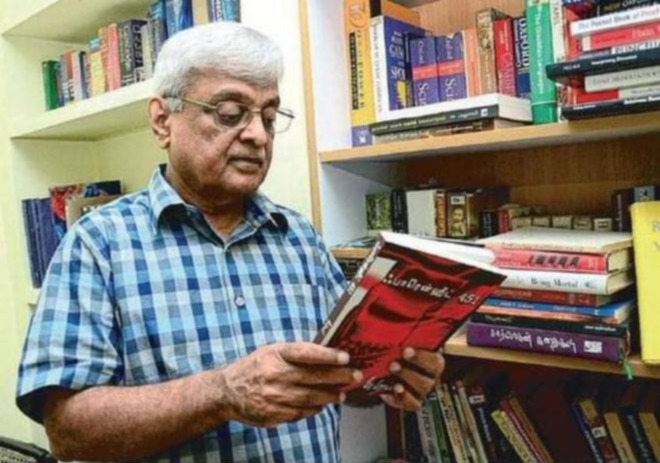Registered with the Registrar of Newspapers for India under R.N.I 53640/91
Vol. XXX No. No. 15, December 1-15, 2020
S. Ramakrishnan – modern Tamil publisher
by Vijaysree Venkatraman
“A well-educated Tamil household,” S. Ramakrishnan said, “will happily spend fifty rupees on an English paperback but will not think of buying a Tamil book.
As they are the ones with the money, this severely limits our markets. Then we face competition from other Tamil publishers – particularly from what are known as monthly novels. They are printed on the cheapest possible paper and sell for only two rupees. It is difficult to wean people away from them, and from the same sort of romantic and sensational stories brought out in serial form in Tamil magazines.”
Ramakrishnan, the founder of the courageous publishing house, Cre-A, died on Nov 17, 2020 at the age of 75, another victim to the Covid-19 pandemic. In a conversation with BBC’s Mark Tully, which the veteran journalist records in the bestseller No Full Stops in India, Ramakrishnan had spoken of the challenges he had faced when he ventured into the world of Tamil publishing in the early 1970s.
Ramakrishnan was a highly paid executive at an ad agency before he forayed into Tamil publishing. A member of the English-speaking elite of Tamil Nadu, he was determined to give Tamil readers well-produced, high quality books in terms of both form and content. “We wanted to do in Tamil what has not been done before. We have to extend the language so people can express themselves,” he told Tully.

A health-care manual translated into Tamil would sell but of its practical utility, but what about books on film or art criticism? How do you bring impractical, but enriching, thoughts and words into people’s consciousness, so it becomes part of their everyday reality? Experts say birding is a gateway to greater environmental awareness, but there was no field guide to birds in Tamil. Such things mattered to Ramakrishnan, whose decision to enter the publishing world was an ideological, not a commercial one.
Quite literally, he brought modern words into the Tamil lexicon. He will be best remembered as the author of Cre-A’s contemporary Tamil dictionary. Bilingual journalist Kavitha Muralidharan, who often comes up with exquisite pen portraits of luminaries from the Tamil literature, reported in the online magazine Scroll that even as Ramakrishnan battled COVID-19 in a government hospital, he was concerned about releasing the third edition of the dictionary, as per schedule, on November 13. He managed to keep that commitment.
Ramakrishnan who encouraged translators of world classics and contemporary literature to do their best work, also nurtured local writers. Many Tamil writers who were used to benign neglect, were shocked at first when he pored over the manuscript and suggested revisions. Soon, they realized that he just wanted their work to shine, be the best it could be. Ramakrishnan would work on the layout with his small team, and send the work of literature, into the world, with tastefully chosen artwork cover art.
Two years ago, when I first met Ramakrishnan at his office in Tirunvanmiyur, I had with me a glossy version of Dilip Kumar’s Ramavum Umavum. Gently, he prised the paperback out of my hands and gave me the Cre-A edition with surreal art on the cover. Ramakrishnan was extremely proud of his protégé’s success. Earlier this year, Dilip’s short story from the same book, The Clerk’s Story, was made into a feature film, Nasir, and it won a prestigious international award. Ramakrishnan sent me the link to the online screening.
Before Dilip Kumar became a renowned writer, he worked in the Cre-A office-cum-showroom. It was located in Royapettah, above a paint shop, and not too far from Pilot theatre. Renowned authors used to drop in, as did people from the world of theater, art, and academia. The atmosphere was very vibrant, Dilip recalls. There would be a collective pondering and exploration of things that help enrich, and sustain, a person’s inner life. The topic could be anything – poetry, painting, philosophy, music, education – depending on the visiting person’s field of interest.
Ramakrishnan knew well people may not always read the books they buy from cover to cover. Still, the impact of good books is subtle and subliminal, and it was very important to have them within reach, and to be open to their influence, he had said some years ago in an interview with a Tamil radio station in Australia. He also encouraged readers who were ready to get started. When I claimed I was a language orphan – because I had not studied my mother tongue in school – Ramakrishnan pulled out a book from the shelf and asked me to read out a few lines. He gave me a collection of short stories by Imayam, so I could practice my Tamil reading. Someday, I hope to read the author-publisher Ramakrishnan’s short stories as well.
Tributes to Ramakrishnan will continue to pour in, but I think it will be hard to beat this one, again from the Scroll article by Muralidharan. It was from Israeli scholar David Shulman, writer of the comprehensive work, Tamil, A Biography. “Every language, and especially an ancient and noble language like Tamil, needs some extraordinary persons to care for it, heal its wounds, and reveal its richness. Ramakrishnan was such a person.”
Shulman goes on to add: “For half a century he was the living heart of modern Tamil. He discovered and published the finest writers, meticulously edited their works, published major works of Tamil scholarship, translated foreign classics into Tamil, and also produced the finest dictionary available for any modern South Asian language. He was a man of impeccable taste, one of the rarest of human virtues. He was a great and loving friend. All those who love Tamil will mourn this terrible loss.”

